Japanese Chicken Meatballs called ‘Tsukune’ are one of the regular yakitori dish items. Soft and bouncy chicken meatballs are skewered and chargrilled with sweet soy sauce, i.e. yakitori sauce. The key to my soft and juicy meatballs is the grated onion and the amount of fat in the chicken mince (ground chicken).
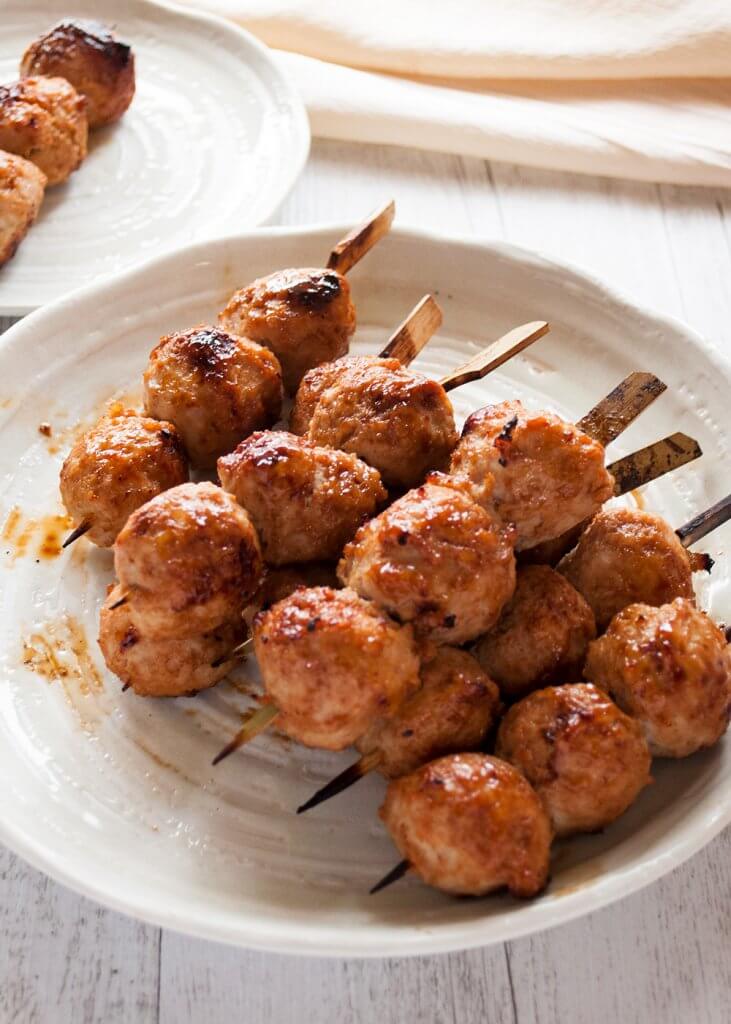
People often think that Tsukune (つくね) is Japanese chicken meatballs. But that is not accurate. Tsukune is a generic name for Japanese-style meatballs. The minced meat (ground meat) does not have to be chicken, it could be pork or even fish.
However, the most popular Tsukune is made with chicken and that’s probably why Tsukune is synonymous with chicken meatballs.
CHICKEN MINCE (GROUND CHICKEN) FOR TSUKUNE
Meatballs for Tsukune have to be soft, bouncy and juicy. To make the texture of the soft and juicy Tsukune, you need to have chicken fat in the mince. The surface of the meatballs needs to be smooth rather than bumpy, which you get when the granular size of the mince is large.
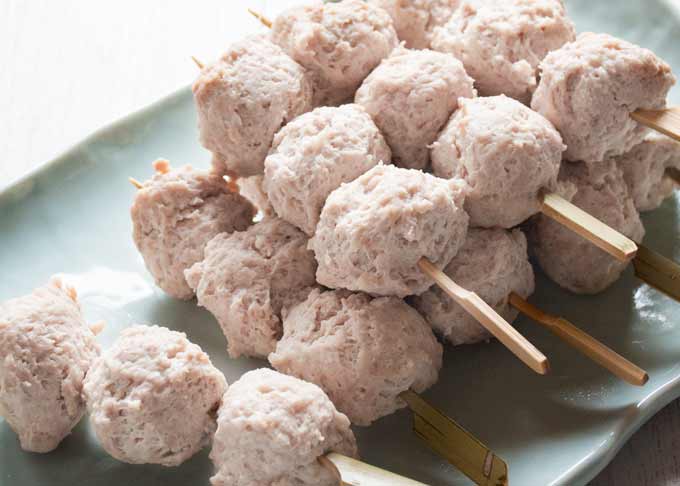
I use a mixture of chicken breast mince and chicken thigh mince, which contains more fat than the breast mince. The breast mince is almost like a paste and it makes the surface of the meatballs smooth. The chicken thigh mince adds fat to the mince that makes the meatballs soft and juicy and compensates for the dryness of the breast mince.
But sometimes, I may have just breast mince. In this case, I add finely minced chicken fat to it so that the meatballs become more moist and soft.
Whenever I trim the fat and remove the skin from the chicken, I save them and freeze them. The chicken skin often has a layer of fat on the inside. I scrape off the fat to make use of it.
You could use a blender to make mince from fillets as well. I tried it with thigh fillets and it worked well. You can mince thigh fillets much finer than those you get from the shop.
HOW TO MAKE Tsukune (Japanese Chicken Meatballs)
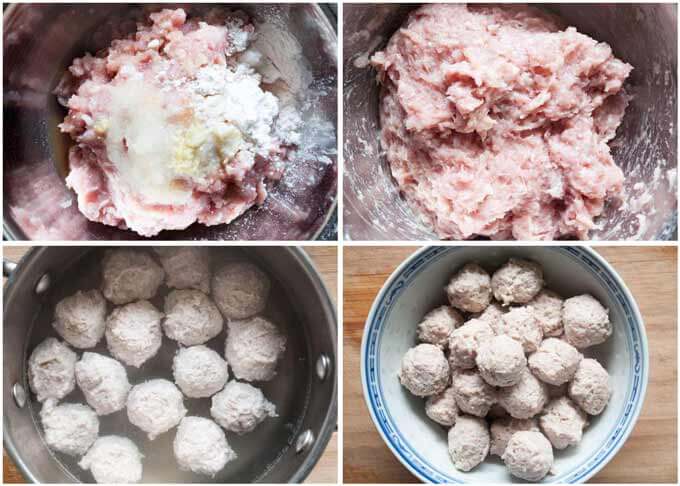
The chicken mince mixture to make Tsukune consists of the following (The list is not short, but all the ingredients are available at supermarkets):
- Chicken mince (50% breast mince + 50% thigh mince), or 90% breast mince + 10% minced chicken fat
- Salt
- Egg
- Grated onion
- Grated ginger (juice only)
- Light soy sauce
- Cornflour/corn starch
- Cooking sake
Drop your meatballs into the boiling water and cook them for 5-7 minutes. This is basically the process of making the basic Tsukune.
Once your meatballs are boiled, there are many different ways of using them to make dishes. Today, I made them in Yakitori-style by putting skewers through them and grilling them with a sweet soy sauce.

MY WAY OF MAKING TSUKUNE (Japanese Chicken Meatballs)
In almost all meatball dishes, when you make the meatball, you take a portion of the meat mixture on your palm, place the other hand to cover the meat, then roll the meat inside your hands to make it round. This method sure can make a perfect ball.
I make Tsukune in the different way. Because the mince mixture in my recipe is quite soft and difficult to roll to make a ball, I do not use the traditional method of making a meatball.
What I do is shown in the step-by-step photo below.
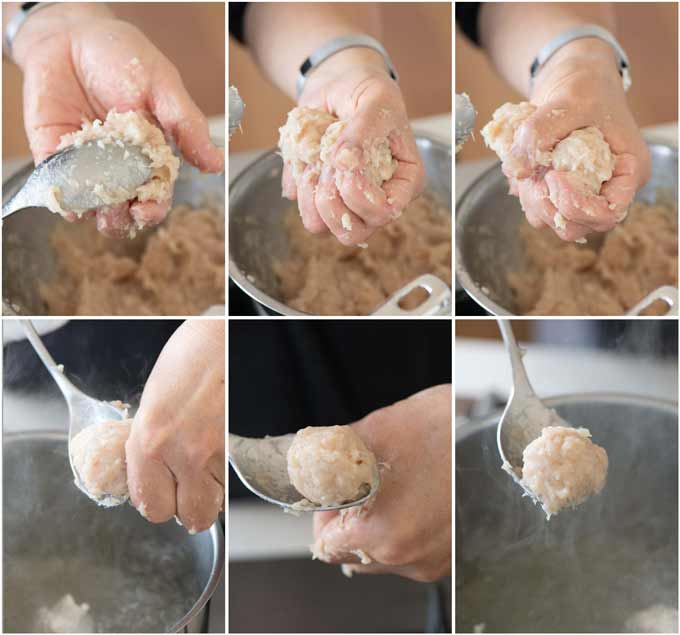
I grab a handful of mince mixture with my left hand (I am a right hander), make a circle with my thumb and index finger and squeeze my hand to push the meat through the circle. The meat comes out shaped like a ball. With my right hand, I use a spoon to scoop the meatball off my left hand and drop it into the boiling water.
TSUKUNE VS TSUMIRE
There is a similar meatball called ‘tsumire’ (つみれ) which is also made with minced meat, most commonly with minced fish. Tsumire made with sardines is a popular ingredient to go into Oden (Simmered One Pot Dish) hot pot. People assume that tsumire is fish meatballs, but it is not so.
The difference between Tsukune and tsumire is the way meatballs are formed.
In the case of Tsukune, minced meat is formed into a ball or a sausage shape using hands. On the other hand, tsumire is made by dropping seasoned minced meat into boiling water or soup using a spoon, or by picking up by hand without forming a particular shape.
Photo below is a traditional tsumire server made of bamboo. Place the mice mixture on the half-pipe bamboo server and simply slide a chunk of mince into the boiling broth using a spatula.
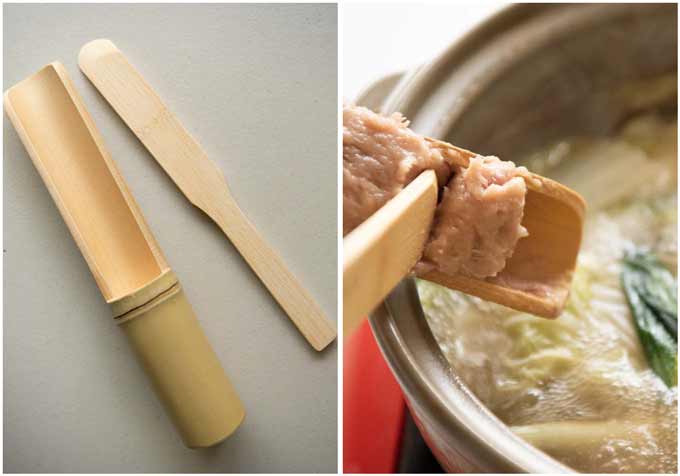
I wanted to add this section because my way of making Tsukune is the combined method of making Tsukune and tsumire. I must post a tsumire dish one day.
YAKITORI-STYLE TSUKUNE (Japanese Chicken Meatballs)
When you serve Tsukune as part of a yakitori dish, put 2 or 3 meatballs through a skewer. Then grill them with either salts sprinkled over them or sweet soy sauce basted on them.
Skewer: The best skewer for the meatballs is called ‘teppō gushi’ (鉄砲串, gun skewer). Unlike the standard round bamboo skewer, the teppō gushi is a narrow flat skewer with a handle at one end. The flat skewer prevents the meatballs from rotating around the skewer when turning the balls on the skewer over. You can buy teppō gushi at Japanese grocery stores. Some online shops also sell them.
Flavouring: The flavour can be either salty or sweet. The salty Tsukune is simply made by sprinkling some salt over the meatballs when grilling. The sweet flavour is made by basting the meatballs in a condensed sauce that is made of soy sauce, mirin and sugar.

I hope you enjoy Japanese Chicken Meatballs (Tsukune) as much as Yakitori (Japanese Skewered Chicken).
Yumiko![]()
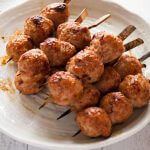
Tsukune (Japanese Chicken Meatballs) is a regular Yakitori dish items. Soft and bouncy chicken meatballs are skewered and chargrilled with sweet soy sauce, i.e. yakitori sauce. The key to my soft and juicy meatballs is the grated onion and the amount of fat in the chicken mince (ground chicken).
Don't forget to see the section 'MEAL IDEAS' below the recipe card! It gives you a list of dishes that I have already posted and this recipe so you can make up a complete meal. I hope it is of help to you.
- 450g / 1lb chicken breast mince (ground, note 1)
- 50g / 1.8oz chicken fat finely minced (note 1)
- ½ tsp salt
- 1 egg (large)
- 1 tbsp grated onion
- 1 tsp ginger juice (squeeze the juice out of grated ginger)
- 1 tsp light soy sauce
- 1½ tbsp cornflour/corn starch
- 1½ tbsp sake
- 40ml / 1.4oz soy sauce (normal Japanese soy sauce)
- 40ml / 1.4oz mirin
- ½ tbsp sugar
-
Add all the Sauce ingredients to a pot and bring it to the boil. Turn down the heat to medium or medium low and simmer for about 4-5 minutes to reduce the quantity by about a third (note 2).
-
Add chicken mince, chicken fat and salt in a bowl and mix well until the chicken mince becomes sticky.
-
Add the remaining ingredients, except 1 tablespoon of sake, to the bowl and mix well.
-
Add the remaining sake to the bowl gradually while mixing. The mixture is quite soft but do not add all of the sake specified if the mixture is too soft to grab by hand and form a ball.
-
Boil water in a pot. Coat a cutlery spoon with oil (not in ingredients).
-
Grab chicken mince with the left hand (I am a right hander) and squeeze out mince through the thumb and the index finger. The mince will come out forming a round shape (note 3).
-
Take the meatball with the spoon and drop it into the pot. Repeat this for the rest of the mince (see the step-by-step photo in post).
-
Boil meatballs for 5-7 minutes until cooked through (note 4). Take the meatballs out and put aside. Cook them in batches so that the surface of the boiling water is filled with no more than one layer of the meatballs.
-
Heat griller, griddle or BBQ (note 6). Oil the rack/grill where you place the meatballs.
-
Thread 3 Tsukune onto flat skewers (note 7).
-
Baste tsukune with the sauce using a brush and cook under the griller or on the griddle/BBQ for 1-2 minutes until the meatballs are slightly burnt.
-
Turn over the skewers and cook further 1-2 minutes. Then baste with the sauce, cook 30 seconds on both sides.
-
Serve immediately.
1. You could have a mixture of 250g / 8.8oz breast mince and 250g / 8.8oz thigh mince, or 100% thigh mince.
You could have just 500g / 1.1lb of breast mince but the meatballs may be slightly dry.
2. The time taken to reduce the sauce depends on the size of the pot. The larger the diameter of the pot, the faster it reduces.
3. The size of the circle made with your thumb and index finger determines the size of the ball and therefore the number of meatballs made in total.
My meatball was 3-3.5cm / 1¼” in diameter and I made 24 meatballs.
4. Cooking time depends on the size of the meatballs. When the meatball is floating and feels light when you pick it up, it is cooked through.
5. I made Tsukune on skewers, but you could cook individually if you like. Or two/four meatballs on each skewer instead of three.
6. The heat can be strong. Because Tsukune is already cooked, all you need to do here is to coat with sauce and get them burnt slightly to give better flavour to them.
7. The flat bamboo skewers used in Yakitori are called 'teppō gushi' (鉄砲串, gun skewer) as the shape is like a gun (in the old days). You can buy teppō gushi at Japanese grocery stores. Some online shops also sell them.
8. Tsukune can be frozen. After boiling, cool them down and freeze them in an air tight container or a freezer bag. To grill, thaw them, then grill as per the instructions.
9. Nutrition per skewer.
serving: 103g calories: 169kcal fat: 8.6g (13%) saturated fat: 0.4g (12%) trans fat: 0.0g polyunsaturated fat: 1.8g monounsaturated fat: 3.5g cholesterol: 70mg (23%) sodium: 594mg (25%) potassium: 280mg (8%) carbohydrates: 6.4g (2%) dietary fibre: 0.4g (2%) sugar: 3.9g protein: 14g vitamin a: 3% vitamin c: 0.7% calcium: 1% iron: 3%
Originally published in November 2016, improved photos and contents with Meal Ideas in April 2020 (no change to recipe).
Meal Ideas
A typical Japanese meal consists of a main dish, a couple of side dishes, a soup and rice. I try to come up with a combination of dishes with a variety of flavours, colours, textures and make-ahead dishes.
The flavouring of the Tsukune is sweet soy sauce. So I avoided side dishes with sweet flavours. If your Tsukune is flavoured with salt, one of the side dishes can be a sweet dish such as Simmered Pumpkin (Kabocha no Nimono).
Tonjiru adds a wider range of vegetables to the meal as well as the different colours.
- Main: Tsukune (Japanese Chicken Meatballs) – can be made ahead up to boiling the meatballs, then grill on the day
- Side dish 1: Sesame Bean Sprouts – make ahead
- Side dish 2: Wasabi Dressing and Watercress Salad – or any other green salad
- Soup: Tonjiru (Pork and Vegetable Miso Soup) – can be made ahead
- Rice: Cooked Rice

Made this tonight. Absolutely delicious. Fun making the chicken balls. Great recipe
Thank you, Liisa. I also like the way the chicken balls are made!
Love the meatballs.
We didn’t have chicken fat but it was still pretty delightful. Nice addition to any BBQ as a different flavour profile.
Hi Olivia, thank you!
We just made the Tsukune and pired it with your Sesame Bean Sprout. AMAZING!!! Thank you for the wonderful recipes.
Hi Leanne, that’s great! I am glad you enjoyed it.
I’m glad that’s I’ve found your exceptional blog by accident , tried that karaage recipe and yeah I’m lovin it ,the taste was so different from karaage that’s sold out there.
I think I’m gonna try all of your recipe here especially the easiest one(not an expert on cooking tho).
Also love you and your cooking from indonesia bless you and keep the good work.
Hi Angga, welcome to my blog and thank you! Let me know how it went when you cook some of my dishes.
Hello I’m Sandrine from France nice to meet you. I would like to make your receipe but i would like to replace sake can you tell me what can I use to replace it? And what is soy sauce : you mean dark soy sauce ?
Thank you so much for your kind answers and so sorry for my english.
Sandrine
Hi Sandrine, instead of sake, you can use dry sherry or Chinese rice wine. If you cannot take alcohol, you could use broth. Unless specifically mentioned, soy sauce is so called dark soy, but not extremely dark soy that you find among Chinese soy sauces. Please visit PANTRY ESSENTIALS FOR JAPANESE HOME COOKING – PART 1, which includes details about soy sauce with sample photos.
Made this tsukune second time w corrected sauce. Came out terrific which I had guest from Los Angeles. Also took suggestions from one
of your guest using the broth with added vegetables n some chicken meatballs. Came out very oishi(ono in Hawaii)
Again Mahalo
Hi Hazel, you are welcome and that’s great!
My husband and somewhat picky son gave thumbs up on this recipe. My son cannot stand crunchy raw onions in any part of his meal so while I ground and prepare the chicken thighs with Kitchen Aid, I let the onion soaked in the sake. I kept the cooking liquid from the meatballs and added cabbage and carrots for a soup to go with the meatballs. Husband said they taste exactly like those we ate from Japanese restaurant. This recipe is a keeper. Thank you so much.
Hi Annie, it is wonderful to hear that everyone like Tsukune. Great idea to make use of the broth and convert it to a soup. Getting a feed back like your husband’s comment makes me happy. Thank you.
Wow! This is going to be my new favourite for putting on the bbq. I love the depth of flavour and it is so convenient to make ahead! I had no idea how to get my hands on chicken fat so I just used chicken thigh and they turned out lovely, not dry at all. Thank you so much for sharing this recipe and making it possible for me to cook something that is so increadibly different from anything I have ever made. (By the way I very much appreciate the time you put into explaining all the details!)
Hi Afra, I am glad you enjoyed it! Your choice of chicken thigh in place of breast mince + fat was the right alternative.
yah!